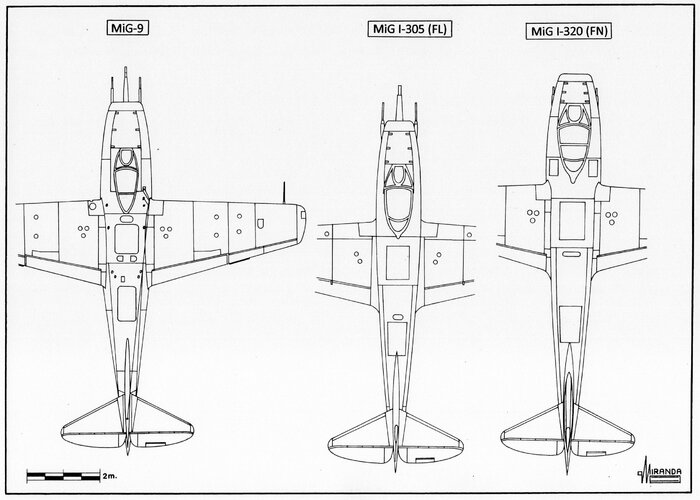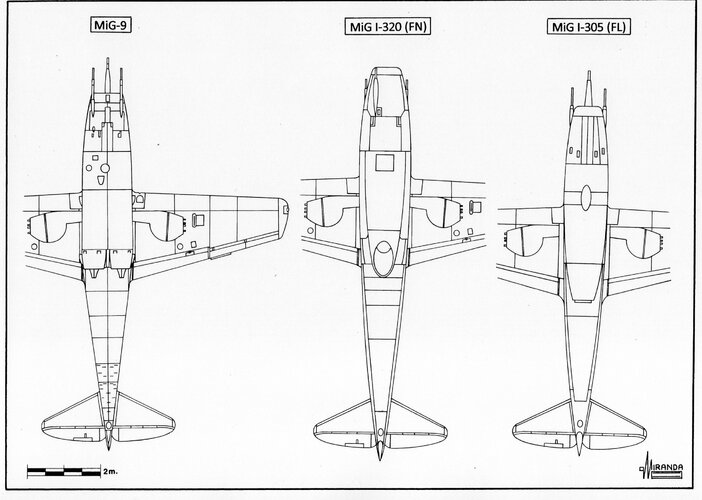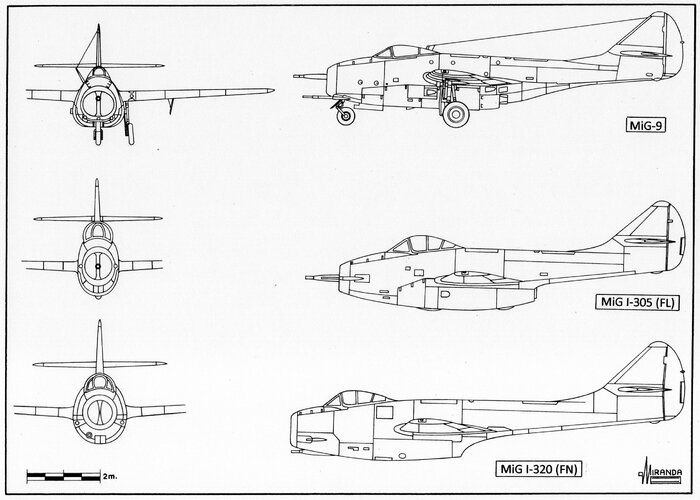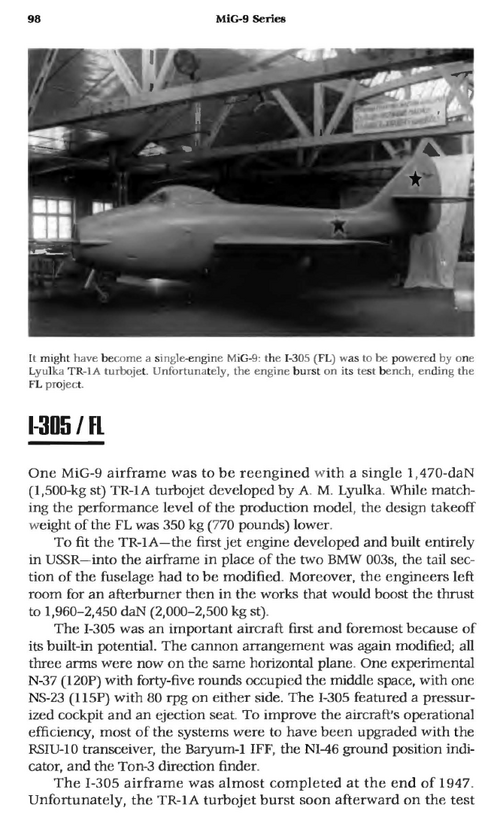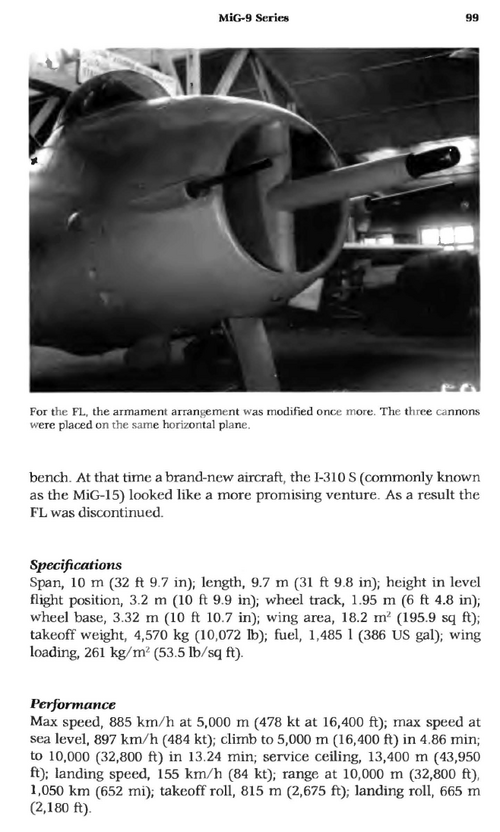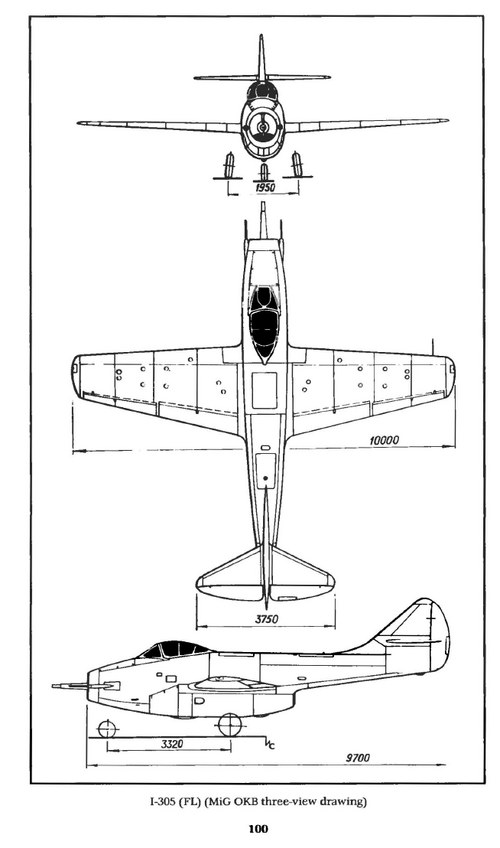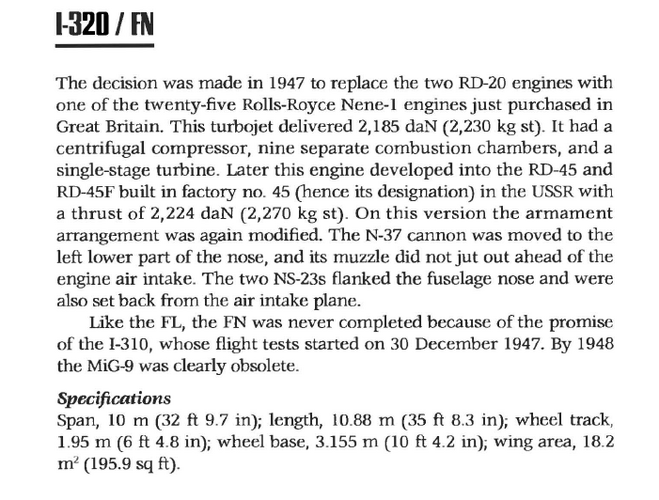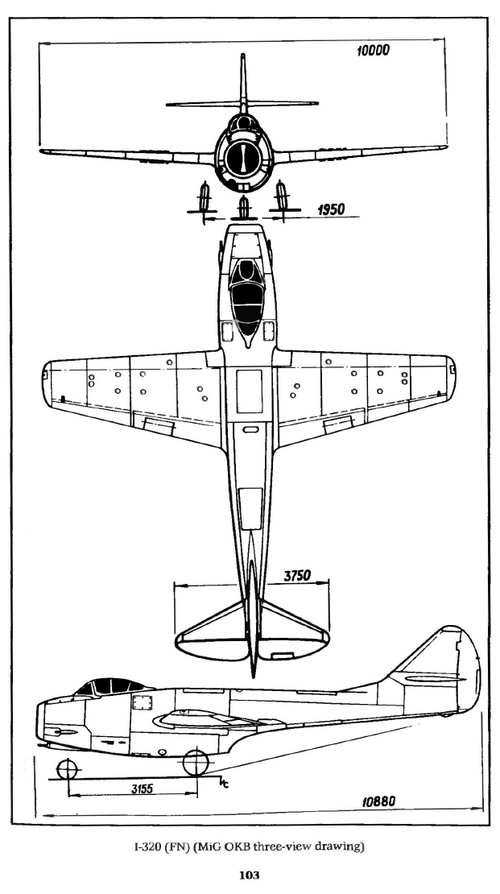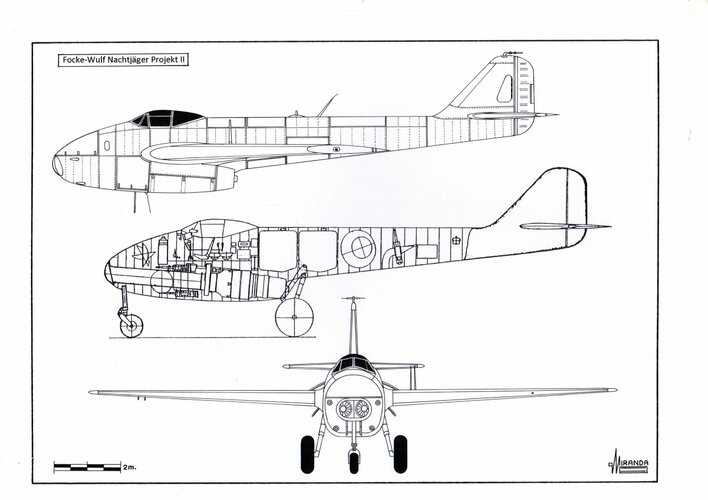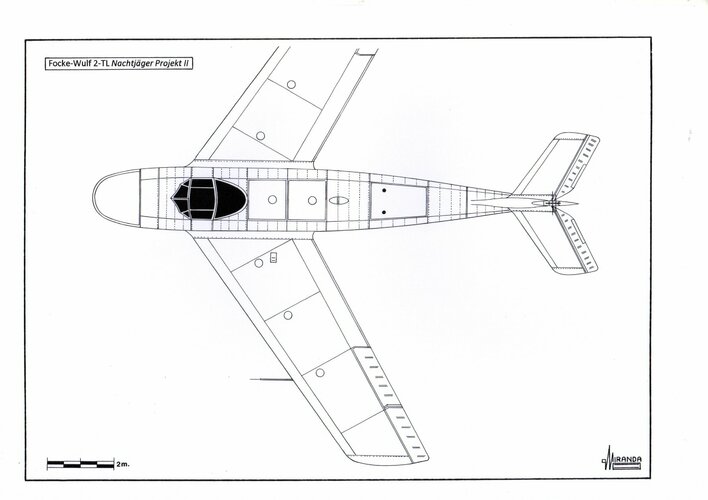MiG-9 single engine variants
In February 1945 Pavel Sukhoi and Mikoyan Gurevich design bureaus were instructed to evolve a single seat heavy fighter of the Me 262 class around a pair of German turbojets.
Owing to the urgency with which the programme was attended, the Sukhoi Su-9 design, with two wing mounted Jumo 004B turbojets was very influenced by the Me 262 captured on March 30, 1945 and flight tested on August 15, 1945.
The MiG OKB-155 decided to use two BMW turbojets placed very close together inside the fuselage, allowed it to fly using only one of them in case of failure, without lateral stability problems.
This aerodynamic solution also generated less drag than the Me 262 formula allowing the new I-300 (MiG-9) fighter to reach higher speeds.
It is at that time the scientists of the TsAGI did not yet have enough data to design swept wings as efficient as those of the Me 262 and the Soviet industry proved to be unable to build reverse engineered copies of the German wings.
German ground tests carried out in November 1944 showed that the internal drag in air ducts reduced the turbojet thrust by 45 kg for each meter in length.
To best profit of the scarce power available the fuselage installation of the MiG-9 turbojets should have air-intake ducts and tailpipes as short as possible to minimize the jet power loss.
MiG OKB decided to incorporate into its design the mid-mounted straight wings, 27 degrees swept delta-style tailplane, tricycle undercarriage with the main gear retracting into the wings and ‘tadpole configuration’ used in the German night fighter project Focke-Wulf Hochleistung Nachtjäger Projekt II (Baubeschreibung Nr.251-251) from March 6, 1945.
The MiG-9 prototype was flight tested on April 24, 1946 reaching 572 mph (920 km/h) at 4,500 m. On July 11, 1946 the plane was destroyed as a result of tailplane structural failure.
MiG-9 technical data
Power plant: two Kuznetsov RD-20 turbojets rated at 850 kg static thrust, wingspan: 32.8 ft. (10 m), length: 32.2 ft. (9.83 m), height: 10.6 ft. (3.23 m), wing surface: 202.2 sq. ft. (18.20 sq. m), take-off weight: 10,956 lb. (4,963 Kg), maximum speed: 572 mph (920 km/h), service ceiling: 44,280 ft. (13,500 m).
To meet the April 1946 specification issued by the Council of People’s Commissars, calling for a jet fighter powered by the indigenous turbojet, the MiG OKB decided to build a lighter version of the MiG-9 powered by only one Lyulka TR-1A turbojet, rated at 1,500 kg. The prototype I-305/FL was completed at the end of 1947 but the Lyulka exploded on the test bench and the FL project was discontinued.
MiG I-305/FL technical data
Power plant: one Lyulka TR-1A turbojet rated at 1,500 kg static thrust, wingspan: 32.8 ft. (10 m), length: 31.8 ft. (9.70 m), height: 10.8 ft. (3.20 m), wing surface: 202.2 sq. ft. (18.20 sq. m), take-off weight: 10,088 lb. (4,570 Kg), estimated maximum speed: 557 mph (897 km/h), estimated service ceiling: 43,952 ft. (13,400 m), equipment: pressurized cockpit and ejector seat.
Following the failure of the Soviet Lyulka VRD-3, TR-1 and TR-1A turbojets and the difficulties encountered by the Soviet industry in obtaining reverse-engineered copies of German turbojets, on June 17, 1946 the Council of People’s Commissars ordered the purchase of ten Rolls-Royce Nene Mk.I and ten Rolls-Royce Derwent V British turbojets.
The British government did not granted manufacturing licenses but Klimov GAZ 116 started the mass production of unlicensed copies under the codenames RD-45 (Nene Mk.I with 2,230 kg thrust), RD-45F (Nene Mk.II with 2,270 kg thrust) and RD-500 (Derwent V with 1,590 kg thrust).
Late in 1947 a production MiG-9 was modified replacing the two RD-20 turbojets with one Nene Mk.I.
To accommodate the new centrifugal engine of 1,257 mm of diameter it was necessary to redesign the fuselage but the project, named I-320/FN (a project without any connection with the I-320 R-1 night fighter) was cancelled in favor of the new I-310 S (MiG-15) swept wing prototype.
MiG I-320/FN technical data
Power plant: one Rolls-Royce Nene Mk.I turbojet rated at 2,230 kg static thrust, wingspan: 32.8 ft. (10 m), length: 35.7 ft. (10.88 m), height: 10.76 ft. (3.23 m), wing surface: 202.2 sq. ft. (18.20 sq. m).
In February 1945 Pavel Sukhoi and Mikoyan Gurevich design bureaus were instructed to evolve a single seat heavy fighter of the Me 262 class around a pair of German turbojets.
Owing to the urgency with which the programme was attended, the Sukhoi Su-9 design, with two wing mounted Jumo 004B turbojets was very influenced by the Me 262 captured on March 30, 1945 and flight tested on August 15, 1945.
The MiG OKB-155 decided to use two BMW turbojets placed very close together inside the fuselage, allowed it to fly using only one of them in case of failure, without lateral stability problems.
This aerodynamic solution also generated less drag than the Me 262 formula allowing the new I-300 (MiG-9) fighter to reach higher speeds.
It is at that time the scientists of the TsAGI did not yet have enough data to design swept wings as efficient as those of the Me 262 and the Soviet industry proved to be unable to build reverse engineered copies of the German wings.
German ground tests carried out in November 1944 showed that the internal drag in air ducts reduced the turbojet thrust by 45 kg for each meter in length.
To best profit of the scarce power available the fuselage installation of the MiG-9 turbojets should have air-intake ducts and tailpipes as short as possible to minimize the jet power loss.
MiG OKB decided to incorporate into its design the mid-mounted straight wings, 27 degrees swept delta-style tailplane, tricycle undercarriage with the main gear retracting into the wings and ‘tadpole configuration’ used in the German night fighter project Focke-Wulf Hochleistung Nachtjäger Projekt II (Baubeschreibung Nr.251-251) from March 6, 1945.
The MiG-9 prototype was flight tested on April 24, 1946 reaching 572 mph (920 km/h) at 4,500 m. On July 11, 1946 the plane was destroyed as a result of tailplane structural failure.
MiG-9 technical data
Power plant: two Kuznetsov RD-20 turbojets rated at 850 kg static thrust, wingspan: 32.8 ft. (10 m), length: 32.2 ft. (9.83 m), height: 10.6 ft. (3.23 m), wing surface: 202.2 sq. ft. (18.20 sq. m), take-off weight: 10,956 lb. (4,963 Kg), maximum speed: 572 mph (920 km/h), service ceiling: 44,280 ft. (13,500 m).
To meet the April 1946 specification issued by the Council of People’s Commissars, calling for a jet fighter powered by the indigenous turbojet, the MiG OKB decided to build a lighter version of the MiG-9 powered by only one Lyulka TR-1A turbojet, rated at 1,500 kg. The prototype I-305/FL was completed at the end of 1947 but the Lyulka exploded on the test bench and the FL project was discontinued.
MiG I-305/FL technical data
Power plant: one Lyulka TR-1A turbojet rated at 1,500 kg static thrust, wingspan: 32.8 ft. (10 m), length: 31.8 ft. (9.70 m), height: 10.8 ft. (3.20 m), wing surface: 202.2 sq. ft. (18.20 sq. m), take-off weight: 10,088 lb. (4,570 Kg), estimated maximum speed: 557 mph (897 km/h), estimated service ceiling: 43,952 ft. (13,400 m), equipment: pressurized cockpit and ejector seat.
Following the failure of the Soviet Lyulka VRD-3, TR-1 and TR-1A turbojets and the difficulties encountered by the Soviet industry in obtaining reverse-engineered copies of German turbojets, on June 17, 1946 the Council of People’s Commissars ordered the purchase of ten Rolls-Royce Nene Mk.I and ten Rolls-Royce Derwent V British turbojets.
The British government did not granted manufacturing licenses but Klimov GAZ 116 started the mass production of unlicensed copies under the codenames RD-45 (Nene Mk.I with 2,230 kg thrust), RD-45F (Nene Mk.II with 2,270 kg thrust) and RD-500 (Derwent V with 1,590 kg thrust).
Late in 1947 a production MiG-9 was modified replacing the two RD-20 turbojets with one Nene Mk.I.
To accommodate the new centrifugal engine of 1,257 mm of diameter it was necessary to redesign the fuselage but the project, named I-320/FN (a project without any connection with the I-320 R-1 night fighter) was cancelled in favor of the new I-310 S (MiG-15) swept wing prototype.
MiG I-320/FN technical data
Power plant: one Rolls-Royce Nene Mk.I turbojet rated at 2,230 kg static thrust, wingspan: 32.8 ft. (10 m), length: 35.7 ft. (10.88 m), height: 10.76 ft. (3.23 m), wing surface: 202.2 sq. ft. (18.20 sq. m).

